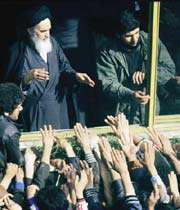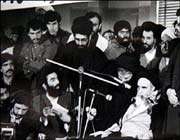Imam Khomeini’s key role in triumph of the Islamic Revolution (Part 2)

In June, the Shah found it politic to make a number of superficial concessions - such as the repeal of the “imperial calendar” -to the forces opposing him, but repression also continued. When the government lost control of Isfahan on August 17, the army assaulted the city and killed hundreds of unarmed demonstrators. Two days later, 410 people were burned to death behind the locked doors of a cinema in Abadan, and the government was plausibly held responsible. On ‘Id al-fitr, which that year fell on September 4, marches took place in all major cities, with an estimated total of four million participants. The demand was loudly voiced for the abolition of monarchy and the foundation of an Islamic government under the leadership of Imam Khomeini. Faced with the mounting tide of revolution, the Shah decreed martial law and forbade further demonstrations. On September 9, a crowd gathered at the Meydan Zhala (subsequently renamed Meydan Shuhada) in Tehran was attacked by troops that had blocked all exits from the square, and some 2000 people were killed at this location alone. Another 2000 were killed elsewhere in Tehran by American-supplied military helicopters hovering overhead.
This day of massacre, which came to be known as Black Friday, marked the point of no return. Too much blood had been spilt for the Shah to have any hope of survival, and the army itself began to tire of the task of slaughter.
As these events were unfolding in Iran, Imam Khomeini delivered a whole series of messages and speeches, which reached his homeland not only in printed form but also increasingly on tape cassettes. His voice could be heard congratulating the people for their sacrifices, denouncing the Shah in categorical fashion as a criminal, and underlining the responsibility of the United States for the killings and the repression. (Ironically, US President Carter had visited Tehran on New Year’s Eve 1977 and lauded the Shah for creating “an island of stability in one of the more troubled areas of the world.”
As the façade of stability dissolved, the United States continued its military and political support of the Shah uninterrupted by anything but the most superficial hesitation). Most importantly, the Imam recognized that a unique juncture had been reached in Iranian history, that a genuinely revolutionary momentum had come into being which if dissipated would be impossible to rebuild. He therefore warned against any tendency to compromise or to be deceived by the sporadic conciliatory gestures of the Shah. Thus on the occasion of ‘Id al-Fitr, when mass demonstrations had passed off with deceptive peacefulness in Tehran, he issued the following declaration: “Noble people of Iran! Press forward with your movement and do not slacken for a minute, as I know full well you will not! Let no one imagine that after the blessed month of Ramadan his God-given duties have changed.

These demonstrations that break down tyranny and advance the goals of Islam are a form of worship that is not confined to certain months or days, for the aim is to save the nation, to enact Islamic justice, and to establish a form of divine government based on justice.”
In one of the numerous miscalculations that marked his attempts to destroy the revolution, the Shah decided to seek the deportation of Imam Khomeini from Iraq, on the assumption, no doubt, that once removed from the prestigious location of Najaf and its proximity to Iran, his voice would somehow be silenced. The agreement of the Iraqi government was obtained at a meeting between the Iraqi and Iranian foreign ministers in New York, and on September 24, 1978, the Imam’s house in Najaf was surrounded by troops. He was informed that his continued residence in Iraq was contingent on his abandoning political activity, a condition he was sure to reject. On October 3, he left Iraq for Kuwait, but was refused entry at the border. After a period of hesitation in which Algeria, Lebanon and Syria were considered as possible destinations, Imam Khomeini embarked for Paris, on the advice of his second son, Hajj Seyyed Ahmad Khomeini, who by now had joined him. Once arrived in Paris, the Imam took up residence in the suburb of Neauphle-le-Chateau in a house that had been rented for him by Iranian exiles in France.
Source: coiradio.com
Other links:
Return of Ayatollah Khomeini to Iran
Shah of Iran flees into exile
Culmination and Victory of the Islamic Revolution
Concept Behind the Islamic Republic of Iran
Khomeini shakes the World